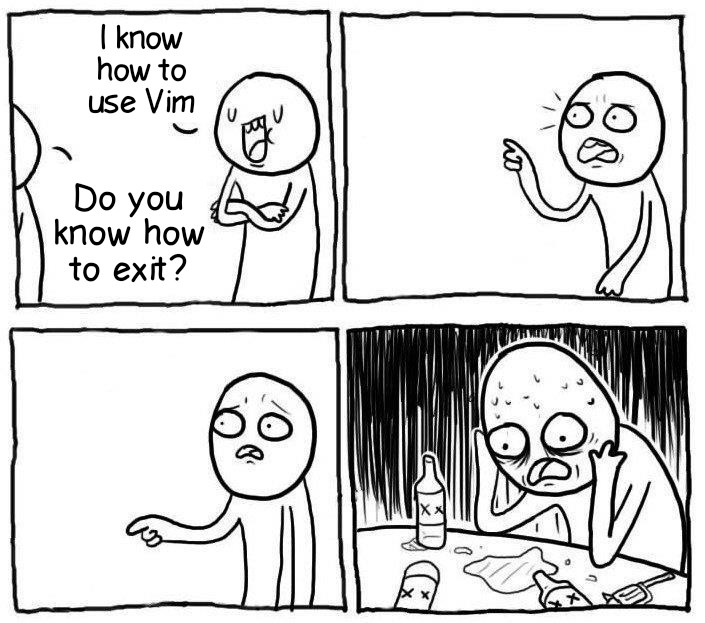Vim is a powerfull text editor. It's useful for programmers and others actually. And does a lot of things for us as common editors can do, like Editing all kind of plain text file. and especially useful for editing programs/codes and so on
so vim is not a graphical editor like vscode and other editor. it based on text and the mouse is not longer need to interactive around vim. (there is a graphical version of vim: gvim)
and for working with vim and do your own actions we use commands. for example for saving the file we use :w[rite] command or for going out of file we can use :q[uit ] command and so on. we check them soon
for more information you can see the man page of vim
$ man vimThis page gives you a lot of information that you can read.
NAME
vim - Vi IMproved, a programmer's text editor
...
DESCRIPTION
Vim is a text editor that is upwards compatible to Vi. It can be used
to edit all kinds of plain text. It is especially useful for editing
programs.
There are a lot of enhancements above Vi: multi level undo, multi win‐
dows and buffers, syntax highlighting, command line editing, filename
completion, on-line help, visual selection, etc.. See ":help
vi_diff.txt" for a summary of the differences between Vim and Vi.
...
Vi is the orignial standard UNIX text-editor. vim is VI Improved the advanced version of the vi and we can say the improved version of vi or whatever.
in most modern system vi has been replaced with vim
$ which vim
/usr/bin/vim
$ readlink /usr/bin/vim
/etc/alternatives/vim
$ readlink /etc/alternatives/vim
/usr/bin/vim.basic
$ which vi
/usr/bin/vi
$ readlink /usr/bin/vi
/etc/alternatives/vi
$ readlink /etc/alternatives/vi
/usr/bin/vim.basicBoth of vim and vi execute the /usr/bin/vim.basic program
also for more information you can see the differences between vi and vim the command :help vi_diff.txt will display the diffrences.
so anyway, why should we use the vim. so let's check this out
So, if you know the vim or let's say text based editor like nano or so.
Imagine a day that you have to edit a file in a server. so what you should do, just connect to server via ssh then edit the file. so as you already know we cannot use graphical editors to edit in server(ofcourse we can but in hard way. like using the Remote SSH extenstion in vscode we can ssh to server via vscode editor). But let's dont do that we need a simple way just for editing a simple file we can use vim and nano or so.
Also vim saves more times. if you can type fast and you can intreract with vim. so good for you, Because your hands is on the keyboard only, and they are closer to each other to working (mouse is no longer need)
For FUN: using vim gives this idea that i'm an expert :) no i'm kidding. it is just a tool and does not really important.
OK let's jump into the working with vim
so let's talk about the vim basics. just an overview of using vim.
$ vim file.txtThis will open the file if does not exists: open the file in swap space.
- Normal: The default mode in vim. Command mode is the default mode
- Command: This mode is very important mode. In this mode we cannot type text and only we access the vim commands that there are a lot of commands/shortcuts that we can use them.
- Insert: In this mode we can edit file like any editor. using keyboard to write text.
- Visual: In this mode we can select a block of text in file. select [multiple line/a block of line]
- Replace: In this mode we can replace the text
Each mode has its own property and particular behaviour.
- i: insert mode
- Esc: back to normal mode
- :q: quit the file
- :q!: force to quit
- :w!: write the file: save
- :wq!: write then quite of file.
🎉 Congratuation: now you can exit of the vim anybody can not exit the vim currently. bu you can :)
Ok very well let's jump into the vim commands that everyone need to know.
Now we are going to look at some important and useful commands.
- Navigation commands
- Insert/Append/Editing
- Cut/Paste/Delete
- Visual Mode
- Search and subsitute
- some commands to write and quit the file
- h, j ,k, l: Move cursor: [left: h, down: j, up: k, right: l]
- Ctrl+y, Ctrl+e: Scrollin the page
- :(line-number): go specific line
- gg, 5gg: Go the a top of file, and go to specific line
- G, 5G: Got the button of file and specific line
- }, {: Move to next and previous paragraph
- ^, $: first and last of a line
- H, M, L: Top/Middle/Button of screen
- w, W: go to first character of the next word
- e, E: go to end of the current word
- b, B: go to before word
- f(c), t(c), F(c), T(c): Go to specific character in line
- i, a, I, A, o, O: insert mode/append/new line
- r, R: replace
- J, gJ: Join bellow line
- u, U: Undo the previose changed
- Ctrl+r: Redo the last change
- :m +-(num) , :m line: move the line
- dd, 4dd, d$, d}, dw: delete and copy in vim clipboard
- yy, 4yy, y$, y{, yw: yank without deleting also copy to clipboard
- x, X: delete a character and copy to clipboard
- p, P, xp: paste/put the copied text
- v: visual mode
- Ctrl+v: visual block
- V: visual line
- >>, <<: Indentation/Shift
- u,U,~: Change case
- /pattern: search after cursur
- ?pattern: search before cursur
- n, N: go next
- [%]s/foo/bar: replace all
foowithbar
- :q!, ZQ: just quit of file without writing
- :w!: write the file
- :wq! ZZ: write file then quit of the file
- :set: set the config and settings of vim
- :set number/nonumber
- :colorscheme theme: change the theme of the vim
- :term[inal]: open a terminal
- :help: user guide
- :!command: execute a command
- Ctrl+v+I(char)ESC: Insert a char to first of multiple line
- Ctrl+a, Ctrl+x: increment and decrement the numbers
- gf: open a file
- vimtutor: vim tutorial: vim tutorial
- .vimrc file: when vim is going up thie file will execute. like
.bashrc


